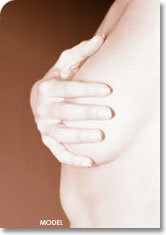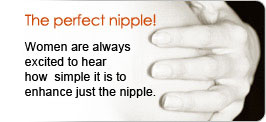About Nipple & Areola Correction
 As many as 2% of American women have at least one inverted nipple and still the subject of nipple inversion is seldom discussed among friends or in the media. Usually when people discuss breast enhancement, they are talking about enlarging, reducing or lifting their breasts.
As many as 2% of American women have at least one inverted nipple and still the subject of nipple inversion is seldom discussed among friends or in the media. Usually when people discuss breast enhancement, they are talking about enlarging, reducing or lifting their breasts.
At Marina Plastic Surgery Associates, we know that breasts play a key part in the way a woman feels about herself, and every aspect of their form and function is important, nipples included. If you’re ready to find out more about changing your nipples, go Inside Online and request an appointment with one of our skilled, sensitive plastic surgeons.
Clearly nipples are an integral part of the breast, playing a role in appearance, in sexuality, and in motherhood. And for the women who have inverted nipples, inversion may affect their self-esteem and body image. While several different surgical techniques have existed for inverted nipples, now there is a treatment that has been successful with long-term results.
Most cases of inverted nipples are congenital – some people are just born that way. However, some nipples become inverted after breastfeeding when scar tissue builds in the milk ducts. Nipples that become inverted after birth are usually caused by one of three things: not enough skin at the base of the nipple, constricted milk ducts, or scarring of the milk ducts due to breastfeeding.
Types of Inverted Nipples
There are three “grades” of inversion – which basically means three levels of severity. While some nipples may only be inverted some of the time (and “come out” or become everted in response to cold or physical touch), others are more severely inverted and never come out. Some women can breastfeed normally, while others will never be able to breastfeed.
- Grade 1. Nipples are inverted but can become everted manually (through stimulation) or in response to cold temperature. They can remain everted for some time. Milk ducts are usually not compromised and breast feeding is possible. These are “shy nipples”.
- Grade 2. Nipples are inverted and are more difficult to evert. The eversion almost never lasts – the nipple returns to the inverted state immediately. Breast feeding could be possible, but this is not a sure thing.
- Grade 3. Nipples are severely inverted and never evert. Milk ducts are often constricted and breast feeding is impossible. Women with Grade 3 inverted nipples may also struggle with infections, rashes, or problems with nipple hygiene.
Read about inverted nipple repair and our unique approach.
To request a consultation just go Inside Online and complete our short, confidential form. You can even save $100 – $150 on your appointment with Dr. Stevens.




